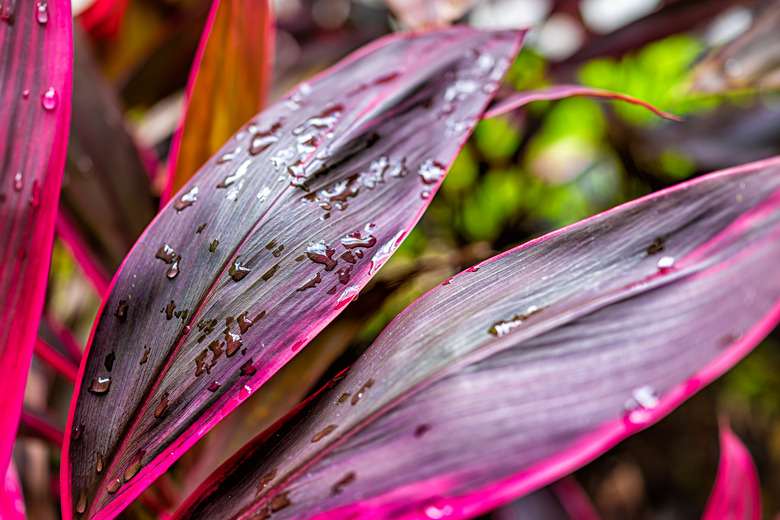How To Grow A Ti Plant From A Cutting
We may receive a commission on purchases made from links.
The Hawaiian Ti plant (Cordyline fruticosa) is grown as a houseplant outside of U.S. Department of Agriculture plant hardiness zones 10 through 12. Propagating and planting a Ti leaf plant from a cutting is relatively simple. Whether rooting a cutting in water or moist soil, allow two to five weeks for roots and new growth to appear before transplanting it into a flowerpot.
About Ti Plants
About Ti Plants
Formerly known as Cordyline terminalis, the Ti plant is a native of the tropical regions of Southeast Asia, Australia, and the Pacific Islands. This perennial grows 3 to 6 feet tall indoors with up to 30-inch-long and 6-inch-wide leaves. The foliage begins as pink-red or green and matures to deep greens, reds, burgundies, purples, or variegated colorations depending on the cultivar.
There are many Cordyline varieties, including the purple to red Hawaiian Boy; red and purple variegated Florida Red; pink- and burgundy-splashed Red Sister; green, pink, and cream variegated Candy Cane and Bolero Tricolor; and the nearly black Caruba Black and Black Magic. All of these Cordyline fruticosa cultivars are frost-tender, hardy only in USDA zones 10 through 12.
Ti Plant Propagation in Water
Ti Plant Propagation in Water
Whether you start with trimmings from an existing plant or a short piece of cane from the garden center, Ti plants need water to sprout. Because they are sensitive to fluoride and chlorine, fill a pitcher with tap water and leave it sitting out for a few days or boil the water for at least 15 minutes so the chemicals evaporate before they contact your Ti plant cuttings. You can also use distilled water. Alternatively, a reverse osmosis water filtration system removes the chlorine and fluoride as well as other contaminants from your tap water.
When your Ti plant gets leggy, put on your gloves and safety goggles, sterilize your cutting tools, and cut the stems to 4 to 6 inches tall. Strip the leaves from the bottom two-thirds of the cutting and then mark and cut the stem in 3-inch sections, leaving at least 3 inches of stem on the leafy top. Use a Sharpie or nail polish and put a dot on the "top" of each section, also known as logs. Allow the ends of the cuttings to dry for one or two days.
To propagate vertical sections, put the leafy cutting in a vase with 1 inch of water in the bottom. Put the logs in a glass of water with the "top" upward or lay them horizontally with one-third to one-half of the log submerged in a water- and pebble-filled tray. Change the water every two to three days, adding 1 teaspoon of 3 percent hydrogen peroxide per cup of water to help oxygenate the water. Monitor for one to three weeks until roots and leaf buds appear.
Ti Cuttings Started in Soil
Ti Cuttings Started in Soil
You can also start your cuttings in moist potting mix. Plant the leafy stem vertically with at least 3 inches of the stem inserted into the planting medium. The leafless logs can also be planted vertically in small flowerpots or nestled horizontally into the potting mix in a tray. Place it in a warm location with bright, filtered light and mist daily. Roots and new growth appear in three to four weeks.
The advantage of placing the logs horizontally in water or moist soil is that at each node, leaf buds and roots will appear, allowing you to divide each log into smaller sections. When sprouted vertically, each log or cutting will produce one new plant. The original plant will also produce new growth from the pruned stems.
Ti Plant Care
Ti Plant Care
When the roots are 1 inch or more in length and the logs are developing new leaves, prepare them for transplanting. Carefully cut the horizontally sprouted logs in sections with a sharp knife and then plant them in an organically rich potting mix. Place the pots in a warm location in partial shade or bright, filtered light from a south-facing window.
Continue to water with distilled water, keeping the soil evenly moist as the plant grows. Mist occasionally to increase the humidity around the Ti plant. Apply a 3-1-2 or 6-2-4 liquid fertilizer diluted to one-half strength monthly when the plant is actively growing in spring through fall. Always water thoroughly after fertilizing.
